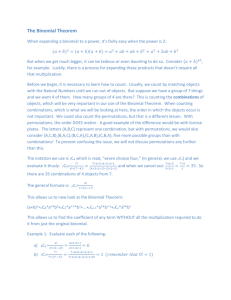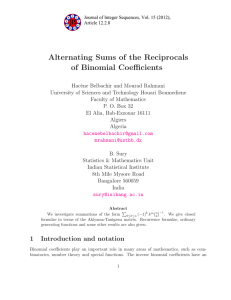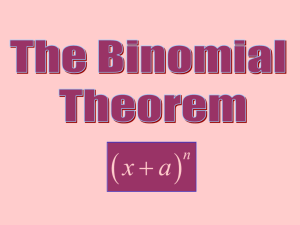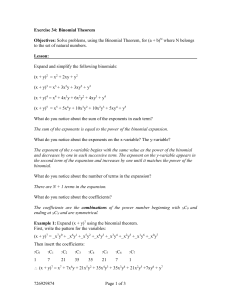Sums Involving Moments of Reciprocals of Binomial Coefficients
advertisement
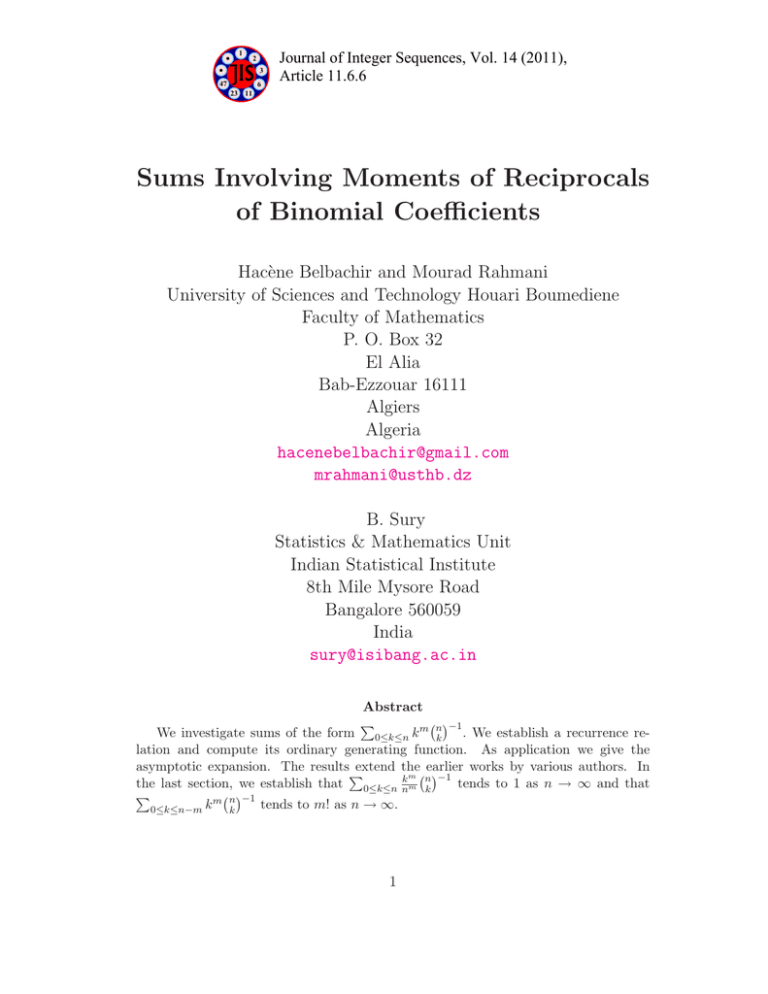
1
2
3
47
6
Journal of Integer Sequences, Vol. 14 (2011),
Article 11.6.6
23 11
Sums Involving Moments of Reciprocals
of Binomial Coefficients
Hacène Belbachir and Mourad Rahmani
University of Sciences and Technology Houari Boumediene
Faculty of Mathematics
P. O. Box 32
El Alia
Bab-Ezzouar 16111
Algiers
Algeria
hacenebelbachir@gmail.com
mrahmani@usthb.dz
B. Sury
Statistics & Mathematics Unit
Indian Statistical Institute
8th Mile Mysore Road
Bangalore 560059
India
sury@isibang.ac.in
Abstract
−1
P
We investigate sums of the form 0≤k≤n k m nk
. We establish a recurrence relation and compute its ordinary generating function. As application we give the
asymptotic expansion. The resultsP
extend the earlier
works by various authors. In
km n −1
the last section, we establish that 0≤k≤n nm k
tends to 1 as n → ∞ and that
P
n −1
m
tends to m! as n → ∞.
0≤k≤n−m k
k
1
1
Introduction
For all nonnegative integers n, m, let
−1
n
X
m n
:=
k
.
k
k=0
Sn(m)
(1)
There are several papers in the literature dealing with sums involving inverses of binomial
coefficients [2, 9, 11, 12, 15, 16, 17, 19]. The cases m = 0 and m = 1 were intensively studied.
In 1947, Staver [13], using the identity
−1 X
−1
n
n
X
n
n
=
,
k
(n − k)
k
k
k=0
k=0
(1)
(0)
obtained a relation between Sn and Sn :
n (0)
S ,
2 n
(2)
n + 2 (0)
S + 1.
2(n + 1) n
(3)
Sn(1) =
(0)
and established a recurrence relation for Sn
(0)
Sn+1 =
Staver also proved for the first time the well-known formula
Sn(0)
n+1
n + 1 X 2k
.
= n+1
2
k
k=1
(4)
For applications of (4), see Nedemeyer and Smorodinsky [5], Mansour and West [7], and
for a probabilistic application, see Letac [4, p. 14]. Finally, for the asymptotic expansion,
see Comtet [1, p. 294] and Yang and Zhao [18].
In 1981, using induction and the relation
−1
−1 −1
n−k
n−1
n
n
−
=
k−1
k
n−k+1 k−1
Rockett [9] proved (3) and (4).
In 1993, Sury [14] connected the inverse binomial coefficients to the beta function as
follows
−1
Z1
n
= (n + 1) xk (1 − x)n−k dx
k
0
and proved the relation (4) (see also [16]). Some years later, Mansour [6], generalized the
idea of Sury [14], and gave an approach based on calculus to obtain the generating function
for related combinatorial identities.
2
Theorem 1 (Mansour [6]). Let r, n ≥ k be any nonnegative integer numbers, and let f (n, k)
be given by
Zu2
(n + r)!
f (n, k) =
pk (t) q n−k (t) dt,
n!
u1
where p (t) and q (t) are two functions defined on [u1 , u2 ] . Let {an }n≥0 and {bn }n≥0 be any
two sequences, and let A (x) , B (x) be the corresponding ordinary generating functions. Then
u
#
" n
Z2
∞
r
X
X
d
f (n, k) ak bn−k xn = r xr A (xp (t)) B (xq (t)) dt .
(5)
dx
n=0 k=0
u1
In particular,
X
Sn(0) xn =
n≥0
and
X
Sn(1) xn = −
n≥0
2
2 ln (1 − x)
−
,
(x − 1) (x − 2)
(x − 2)2
2x ln (1 − x)
x (3x − 4)
.
2
2 +
(x − 1) (x − 2)
(x − 2)3
We shall use the following well-known basic tools [3]:
(i) The Stirling numbers of the second kind nk (A008277), can be defined by the generating function
k
Xn
Y
x
xn .
=
1 − jx n≥k k
j=1
The most basic recurrence relation is
n+1
n
n
=
+k
,
k
k−1
k
with n1 = nn = 1. An important relation involving nk is
n
X
n+k n
n
x (x + 1) · · · (x + k − 1) .
x =
(−1)
k
k=0
(ii) The Eulerian numbers
n
k
(A008292) are defined by
X
k
n
i
n n+1
, n ≥ k ≥ 1.
=
(−1) (k − i)
i
k
i=0
Which also satisfy the recursive relation
n
n−1
n−1
=k
+ (n − k + 1)
,
k
k
k−1
with 11 = 1.
3
(6)
(iii) The Worpitzky numbers Wn,k (A028246), are defined by
Wn,k =
k
X
i+k
(−1)
i=0
k
.
(i + 1)
i
n
They can also be expressed through the Stirling numbers of the second kind as follows
n+1
Wn,k = k!
.
(7)
k+1
The Worpitzky numbers satisfy the recursive relation
Wn,k = (k + 1) Wn−1,k + kWn−1,k−1 (n ≥ 1, k ≥ 1) .
(8)
Some simple properties related to these three remarkable sequences are
n
n X
n k X
x =
(x − 1)n−k kWn−1,k−1 ,
k
k=0
k=0
(9)
n X
n k
k=0
and
k
t
n+1
,
=
t+1
n X
n k+1
k
k=0
2
t
= Wn,n−t .
(10)
(11)
(2)
Some results on Sn
(2)
In this section, we give some results concerned Sn . Applying Theorem 1, for an = n2 and
bn = 1, we obtain, for |x| < 1,
x(x + 1)
A(x) =
,
(1 − x)3
and
1
,
B(x) =
1−x
(2)
from (5) we get the generating function for Sn
1
Z
X
d
xt (xt + 1)
dt
Sn(2) xn =
x
3
dx
(1
−
xt)
(1
−
x
+
xt)
n≥0
0
ln(1 − x)
2x (2x3 − 3x2 − 3x + 5)
2
=
−
2
x
+
2x
−
2
.
(x − 2)3 (x − 1)3
(x − 2)4
(2)
(0)
In addition, we have a relation between Sn and Sn given by the following theorem.
4
(12)
(2)
Theorem 2. If n is a nonnegative integer, then Sn satisfies the recursion relation
(2)
Sn+1 =
(n − 1) (n + 2)2 (2) (n + 2) (n2 − 2n − 2)
,
Sn +
2 (n − 2)
2 (n − 2) (n + 1)2
(13)
and
1
1
(n + 1) (n − 2) Sn(0) + (n + 1)2 .
(14)
4
2
−1
(2)
Proof. We use the WZ method [8]. Denote the summand in Sn by L (n, k) := k 2 nk , by
the Zeilberger’s Maple package EKHAD, we construct the function
−1
n
2 2
2
2
G (n, k) = n k + n + 3nk − nk + 2 + 2k − 2k (n + 1 − k)
k
such that
Sn(2) =
(n − 1) (n + 2)2 L (n, k) − 2 (n − 2) (n + 1)2 L (n + 1, k) = G (n, k + 1) − G (n, k) .
By summing the above telescoping equation over k from 0 to n − 1, we obtain the following
recurrence relation
n−1
n−1
X
X
(n − 1) (n + 2)2
L (n, k) − 2 (n − 2) (n + 1)2
L (n + 1, k) = G (n, n) − G (n, 0) ,
k=0
k=0
that we can rewrite
(2)
(n − 1) (n + 2)2 Sn(2) − (n − 1) (n + 2)2 n2 − 2 (n − 2) (n + 1)2 Sn+1
2
n
2
2
+ (n + 1) = n3 (n − 1),
+ 2 (n − 2) (n + 1)
n+1
as desired. We prove the relation (14) by induction on n, the result clearly holds for n = 0,
we now show that the formula for n + 1 follows from (13) and induction hypothesis
(2)
Sn+1
(n − 1) (n + 2)2
=
2 (n − 2) (n + 1)2
1
1
(n + 1) (n − 2) Sn(0) + (n + 1)2
4
2
+
(n + 2) (n2 − 2n − 2)
.
2 (n − 2)
Applying (3), we obtain
(2)
Sn+1 =
1
1
(0)
(n + 2) (n − 1) Sn+1 + (n + 2)2 .
4
2
This completes the proof.
Using the relation
n
X
k=0
−1
k 3 nk
obtain the following identity
=
n
X
(n − k)3
k=0
(3)
between Sn
n −1
k
and relations (2) and (14), we easily
(0)
and Sn .
Corollary 3. For any nonnegative integers n, we have
1
3
Sn(3) = n n2 − 3n − 6 Sn(0) + n (n + 1)2 .
8
4
5
3
Generalization
Before stating the main result of this section, we need a lemma.
Lemma 4.
j−1
(0)
Sn+j
X
1
1
(0)
S
+
n
j
r
2 (n + 1)
2 (n + j − r + 1)
r=0
= (n + j + 1)
!
,
(15)
Proof. We proceed by induction on j. For j = 0 the identity (15) holds. Now suppose that
(15) holds for some j and replace n by n + 1 in (15), then using relation (3) the result
follows.
Theorem 5. For any nonnegative integers m and n, we have
Sn(m)
=
m
X
(−1)
m+j
j=0
n+j
Wm,j
n
(0)
Sn+j
!
j−1
X
1
r! (n + j − r)! ,
−
(n + j)! r=0
with the usual convention that the empty sum is 0.
(m)
Proof. We can write Sn
as follows
Sn(m)
n
X
−1
n
=
((k + 1) − 1)
,
k
k=0
m
n −1 X
X
n
m−i m
(k + 1)i ,
(−1)
=
i
k
i=0
k=0
m
and with (6), we obtain
Sn(m)
X
i
i
m
i+j
(k + 1) · · · (k + j) ,
(−1)
(−1)
=
j
i
k
j=0
i=0
k=0
m
i
n
XXX 1
i
m+j m
k! (k + 1) · · · (k + j) (n − k)!.
=
(−1)
j
i
n!
k=0 i=0 j=0
m
n −1 X
X
n
m−i
After some rearrangement,
Sn(m)
m X
i
n X
X
−1
n+j
i
m
,
(n + 1) · · · (n + j)
(−1)
=
k
+
j
j
i
k=0 i=0 j=0
−1
n+j m X
i
X
(n + j)! X n + j
i
m+j m
=
j!
(−1)
.
i
j
n!j!
r
i=0 j=0
r=j
m+j
Now, from (10) and (11), the result holds.
6
(16)
Setting m = 4 in (16), we have the following
Corollary 6. If n is a nonnegative integer, then
Sn(4) =
1
1
(n + 1) n3 − 7n2 − 2n + 16 Sn(0) + (7n − 8) (n + 1)3 .
16
8
Theorem 7. For any nonnegative integers m and n
(m)
Sn+1
m+1
1 X m + 1 (j)
= δ0m +
Sn ,
n + 1 j=0
j
where δij is the Kronecker symbol.
n+1 n Proof. Recall that n+1
= k k−1 , we have
k
n+1
X
km
k=0
n+1
X
−1
n+1
k
n+1 = δ0m +
k
k
k=1
−1
n+1
1 X m+1
n
= δ0m +
k
n + 1 k=1
k−1
−1
n
1 X
m+1 n
(k + 1)
= δ0m +
k
n + 1 k=0
n −1
m+1
1 X m+1 X j n
.
k
= δ0m +
k
j
n + 1 j=0
k=0
m
This proves the theorem.
Setting m = 1 in (17) and using (14), we have the following
Corollary 8. If n is a nonnegative integer, then
(1)
Sn+1 =
4
n + 2 (1) 1
S + (n + 1) .
2n n
2
Ordinary generating function
We apply Theorem 1, for an = nm (m ≥ 1), bn = 1, and for |x| < 1 we have
m
m X
1
m k+1 X (−1)m+k
A (x) =
Wm,k ,
x
=
(1 − x)m+1 k=0 k
(1 − x)k+1
k=0
X
1
.
B (x) =
xn =
1−x
n≥0
7
(17)
From (5), we get
X
d
x
=
dx
Sn(m) xn
n≥0
Z1
0
m P
m
k=0
(1 − xt)
k
m+1
k+1
(xt)
dt
.
(1 − x + xt)
(18)
Making the substitution xt = y in the right-hand side of (18), we obtain
m P
m
k+1
y
Zx
k
X
d
k=0
(m) n
Sn x =
dy
m+1
.
dx
(1
−
y)
(1
−
x
+
y)
n≥0
0
Since the degree of the denominator is at least one higher than that of the numerator, this
fraction decomposes into partial fractions of the form
m P
m
k
k=0
m+1
(1 − y)
y k+1
m
(m)
X αs (x)
α(m) (x)
=
.
+
1 − x + y s=0 (1 − y)m−s+1
(1 − x + y)
We note in passing that (19) is equivalent to
m
m X
X
m k+1
m+1 (m)
y
= (1 − y)
α (x) + (1 − x + y)
(1 − y)s αs(m) (x)
k
s=0
k=0
=
m
X
(19)
(20)
(−1)m+k y (1 − y)m−k Wm−1,k−1 .
k=0
For y = 1 and using the fact that Wp,p = p! for p ≥ 0, we immediately obtain the well-known
identity
m X
m
= m!.
k
k=0
Next, if we set y = 0 for |x| < 1, we obtain the following relation between α(m) (x) and
(m)
αs (x)
m
X
α(m) (x)
αs(m) (x) =
.
(21)
x−1
s=0
Proposition 9. For m ≥ 1, we have
αs(m)
s
m X
X
(−1)i+s m k + 1
(x) =
s−i
(2 − x)i+1 k
k=0 i=0
m
X
(−1)m+j
Wm,j .
=
(2 − x)s−m+1+j
j=m−s
8
(22)
and
α
(m)
m X
1
m
(x) =
(x − 1)k+1
m+1
k
(2 − x)
k=0
m
X
(−1)m+j
=
j+1 Wm,j ,
(2
−
x)
j=0
(23)
(m)
= αm
(x) .
Proof. We verify that (22) and (23) satisfy (20). Denote the right-hand side of (20) by
R(m) (y)
m
X
R(m) (y) = (1 − y)m+1 α(m) (x) + (1 − x + y)
(1 − y)s αs(m) (x) .
s=0
After some rearrangement, we get
R
(m)
m (1 − y)m+1 X m
(y) =
(x − 1)k+1 +
m+1
k
(2 − x)
k=0
s
m X
m
X
X
(−1)i+s m k + 1
s
(1 − x + y)
(1 − y)
s−i
(2 − x)i+1 k
s=0
k=0 i=0
"
m X
(1 − y)m+1
m
k+1
=
+
m+1 (x − 1)
k
(2
−
x)
k=0
#
m
s 1 − x + y X (1 − y)s X k + 1
(−1)j (2 − x)j ,
j
2 − x s=0 (2 − x)s j=0
using binomial formula, we obtain
R
(m)
"
m k+1 X
(1 − y)m+1 X k + 1
m
(2 − x)j (−1)j +
(y) =
m+1
k
j
(2 − x)
j=0
k=0
m
s X
(1 − y)s X k + 1
(−1)j (2 − x)j −
s
j
(2 − x) j=0
s=0
#
m
s X
(1 − y)s+1 X k + 1
(−1)j (2 − x)j .
s+1
j
(2
−
x)
s=0
j=0
9
Now, for k ≤ m
R
(m)
(y) =
m X
m
k
k=0
"
m+1
X
m+1 (1 − y)s X k + 1
(2 − x)j (−1)j +
s
j
(2
−
x)
s=m+1
j=0
m
s s
X (1 − y) X
k+1
(−1)j (2 − x)j −
s
j
(2
−
x)
s=0
j=0
#
m
s X
(1 − y)s+1 X k + 1
j
j
(−1) (2 − x)
j
(2 − x)s+1 j=0
s=0
"
s m m+1
X (1 − y)s X
X
k+1
m
(−1)j (2 − x)j −
=
s
j
(2
−
x)
k
s=0
j=0
k=0
m+1
X
s=1
=
m X
m
k=0
k
"
1+
m+1
X
(1 − y)s
(2 − x)s
s=1
s X
k+1
j
j=0
#
s−1 (1 − y)s X k + 1
j
j
(−1) (2 − x)
j
(2 − x)s j=0
(−1)j (2 − x)j −
s−1 X
k+1
j=0
j
(−1)j (2 − x)j
Finally,
R
(m)
(y) =
m X
m
k=0
k
1+
k+1 X
k+1
s=1
s
(y − 1)
Now, according to (11) and (7), we have
αs(m)
s
!
m X
m k+1
y .
=
k
k=0
s
m X
(−1)i+s X m k + 1
(x) =
s−i
(2 − x)i+1 k=0 k
i=0
s
X
(−1)i+s (m − s + i)!
m+1
=
m−s+i+1
(2 − x)i+1
i=0
s
X
(−1)i+s
i+1 Wm,m−s+i
(2
−
x)
i=0
m
X
(−1)m+j
=
s−m+1+j Wm,j ,
(2
−
x)
j=m−s
=
10
!#
.
on the other side, it follows from (9) that
α
(m)
(x) =
m−1
X
(−1)m+j+1
j=0
=
=
m−1
X
j=0
m
X
j=0
(j + 1) (x − 1)
Wm−1,j
(2 − x)j+2
m−1
X (−1)m+j
(−1)m+j
(j + 1) Wm−1,j −
(j + 1) Wm−1,j
(2 − x)j+1
(2 − x)j+2
j=0
m
X (−1)m+j
(−1)m+j
(j + 1) Wm−1,j +
jWm−1,j−1 .
(2 − x)j+1
(2 − x)j+1
j=0
Using (8), we get α(m) (x) as desired. This completes the proof.
Now, Integrating the right-hand side of (19) over y, we obtain
Zx
0
m P
m
k=0
k
y k+1
(1 − y)m+1 (1 − x + y)
dy =
− 2α
(m)
(x) ln (1 − x) +
m−1
X
s=0
(m)
αs (x)
1 − (1 − x)s−m . (24)
s−m
(m)
By differentiating (24) we get the ordinary generating function of Sn
X
n≥0
Sn(m) xn = −2
d (m)
α(m) (x)
α (x) ln (1 − x) +
+
dx
1−x
m−1
X d αs(m)
dx
s=0
with
m
X (m)
(x)
1 − (1 − x)s−m +
αs (x) (1 − x)s−m−1 (25)
s−m
s=0
m
X
d (m)
(s − m + j + 1) (−1)m+j
Wm,j .
α (x) =
dx s
(2 − x)s−m+j+2
j=m−s
With Proposition 9, we can now rewrite (25) as follows
Theorem 10. For any real number x such that |x| < 1 and for all positive integers m ≥ 1,
we have
!
m
m+j+1
X
X
2
(j
+
1)
(−1)
Sn(m) xn =
Wm,j ln (1 − x)
j+2
(2
−
x)
j=0
n≥0
!
s−m X
(−1)j Wm,m−j (s − j + 1) 1 − (1 − x)
+ (1 − x)s−m−1
+
s−j+1
(s − m) (2 − x)
(2 − x)
0≤j≤s≤m−1
m
1 X 2 (−1)j+m
+
Wm,j .
1 − x j=0 (2 − x)j+1
11
5
Asymptotic expansion
(0)
Yang and Zhao [18] proved recently the asymptotic expansions for Sn
following type:
Sn(0) ∼ 2 +
and
Sn(1)
n
∼
2
1
2
− n−1 , n → ∞,
n−1 2
2+
1
2
− n−1
n−1 2
(1)
and Sn
of the
(26)
, n → ∞.
However, there are finer asymptotics which we proceed to discuss now. We note that the
following claim is consistent with Theorem 7.
Sn(m) ∼ nm , n → ∞.
(m)
It is not difficult to observe that Tn
:=
n−m
X
km
k=0
n −1
k
also converges as n → ∞ and, we
prove alongside the above asymptotic formula that this limit is m!.
Theorem 11. For m > 0, we have
lim Tn(m) = m!,
n→∞
and
(m)
Sn
lim m = 1.
n→∞ n
(0)
Proof. Let us denote the sum Sn by Sn for simplicity just in this proof. One has the
S
+ 1 (see [14], for instance). Using this, it can be shown
recurrence relation Sn = n+1
2n n−1
that
Sn → 2,
n(Sn − 2) → 2,
n(n(Sn − 2) − 2) = n2 Sn − 2n2 − 2n → 4,
and so on. More generally, there are constants a0 , a1 , a2 , . . . such that, recursively
(k−1)
u(k)
− ak−1 ,
n = nun
u(k)
n → 0 as n → ∞,
(0)
where un = Sn − 2.
In other words, for all k ≥ 1,
nk Sn − (2nk + a0 nk−1 + · · · + ak−2 n) → ak ,
12
as n → ∞, for some ak .
In fact, the sequence a0 , a1 , . . . is 2, 4, 16, 88, 616, 5224, . . . is described by the generating
function
X xn
2
an
=
.
n!
(2 − ex )2
n≥0
The constants can also be defined as
ak =
k
X
(r + 2) Wk,r − (r + 1) Wk−1,r ,
r=0
or recursively as
ak = 4 +
k X
k+1
r=1
r
k
+
(−1)r (2 − a0 + a1 − · · · ± ar−1 ) + (−1)k+1 (2 − a0 + · · · ± ak−1 ).
r
This is seen from
2nk+1 Sn = nk (2nSn )
= nk ((n + 1)Sn−1 + 2n)
= (nk+1 + nk )Sn−1 + 2nk+1
k X
k
k+1
(n − 1)r Sn−1 + 2nk+1 .
+
=
r
r
r=1
Write
X m = c0 + c1 (X + 1) + c2 (X + 1)(X + 2) + · · · + cm (X + 1)(X + 2) · · · (X + m),
(27)
where ci ’s depend on m (cm = 1). We have
Tn(m)
n−m
X
−1
n
=
(c0 + c1 (k + 1) + c2 (k + 1)(k + 2) + · · · + cm (k + 1)(k + 2) · · · (k + m))
k
k=0
n−m
n−m
n−m
X n + m−1
X n + 1−1
X n−1
= c0
+ · · · + cm (n + 1) · · · (n + m)
+ c1 (n + 1)
k+m
k
+
1
k
k=0
k=0
k=0
!
!
−1
−1
n+1
n
X
X
n+1
n
− 1 + ···
= c 0 Sn −
+ c1 (n + 1) Sn+1 −
k
k
k=n−m+2
k=n−m+1
!
n+m
X n + m−1 m−1
X n + m−1
· · · + cm (n + 1) · · · (n + m) Sn+m −
−
.
k
k
k=n+1
k=0
A computation using the above result
nk Sn − (2nk + a0 nk−1 + · · · + ak−1 n + ak ) → 0,
13
shows
lim Tn(m) = 0!c0 + 1!c1 + 2!c2 + · · · + (m − 1)!cm−1 + 2(m!)cm .
n→∞
This can be shown by induction on m. The proof is finished by observing that cm = 1 and
0!c0 + 1!c1 + 2!c2 + · · · + m!cm = 0,
which follows by looking at the constant term of (27). This finishes the proof of the first
assertion. For the second one, we proceed similarly to the above discussion. We have
−1
n
X
n
(m)
Sn =
(c0 + c1 (k + 1) + c2 (k + 1)(k + 2) + · · · + (k + 1)(k + 2) · · · (k + m))
k
k=0
!
−1
1 X
n+2
+ ···
= c0 Sn + c1 (n + 1) (Sn+1 − 2) + c2 (n + 1)(n + 2) Sn+2 − 2
k
k=0
!
m−1
X n + m−1
.
· · · + (n + 1) · · · (n + m) Sn+m − 2
k
k=0
Thus, looking at the largest degree factor, we obtain
Sn(m) ∼ nm .
A corollary of the above proof is that the sum
Sn(0) = 2 +
2
4
16 88 616 5224
+ 2 + 3 + 4 + 5 + 6 + ··· ,
n n
n
n
n
n
as n → ∞.
6
Acknowledgment
The authors are indebted to the referee for making constructive suggestions for improvement.
(m)
The asymptotic result Sn ∼ nm was pointed out by the referee and we have revised the
paper to replace the earlier asymptotics by it. The referee has a rather different approach
to the results of this paper and we look forward to seeing his proof in print soon.
The first and the second author were partially supported by CMEP project 09 MDU 765.
References
[1] L. Comtet, Advanced Combinatorics, Reidel, 1974.
[2] P. Juan, The sum of inverses of binomial coefficients revisited. Fib. Quart. 35 (1997),
342–345.
14
[3] R. Graham, D. Knuth, and O. Patashnik, Concrete Mathematics, Addison-Wesley Publishing Company, 1994.
[4] G. Letac, Problèmes de probabilité, Presses Universitaires de France, 1970.
[5] F. Nedemeyer and Y. Smorodinsky, Resistances in the multidimensional cube. Quantum
7 (1) (Sept./Oct. 1996), 12–15, 63.
[6] T. Mansour, Combinatorial identities and inverse binomial coefficients. Adv. in Appl.
Math. 28 (2002), 196–202.
[7] T. Mansour and J. West, Avoiding 2-letter signed patterns. Semm. Lothar. Combin.
49 (2002/04), Art. B49a.
[8] M. Petkovsek, H. S. Wilf and D. Zeilberger, A = B, A. K. Peters, 1996.
[9] M. A. Rockett, Sums of the inverses of binomial coefficients. Fib. Quart. 19 (1981),
433–437.
[10] N. J. A. Sloane, The On–Line Encyclopedia of Integer Sequences. Published electronically at http://www.research.att.com/~njas/sequences, 2010.
[11] A. Sofo, General properties involving reciprocals of binomial coefficients. J. Integer
Sequences 9 (2004), Article 06.4.5.
[12] R. Sprugnoli, Sums of the reciprocals of central binomial coefficients. Integers 6 (2006),
Paper A27.
[13] T. B. Staver. Om summasjon av potenser av binomialkoeffisientene. Norsk Mat. Tidssker
29 (1947), 97–103.
[14] B. Sury, Sum of the reciprocals of the binomial coefficients. European J. Combin. 14
(1993), 351–353.
[15] B. Sury, Tianming Wang, and Feng-Zhen Zhao. Some identities involving reciprocals of
binomial coefficients. J. Integer Sequences 7 (2004), Article 04.2.8.
[16] T. Trif, Combinatorial sums and series involving inverses of binomial coefficients. Fib.
Quart. 38 (2000), 79–84.
[17] J.-H. Yang and F.-Z. Zhao. Sums involving the inverses of binomial coefficients. J.
Integer Sequences 9 (2006), Article 06.4.2.
[18] J.-H. Yang and F.-Z. Zhao. The asymptotic expansions of certain sums involving inverse
of binomial coefficient. International Mathematical Forum 5 (2010) 761–768.
[19] F.-Z. Zhao and T. Wang. Some results for sums of the inverses of binomial coefficients.
Integers 5 (2005), Paper A22.
15
2000 Mathematics Subject Classification: Primary 11B65; Secondary 05A10, 05A16.
Keywords: Binomial coefficient, recurrence relation, generating function, asymptotic expansion.
(Concerned with sequences A008277, A008292, and A028246.)
Received December 1 2010; revised versions received December 8 2010; May 28 2011. Published in Journal of Integer Sequences, June 10 2011.
Return to Journal of Integer Sequences home page.
16


